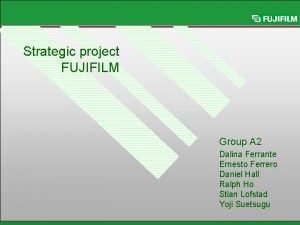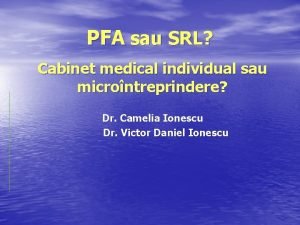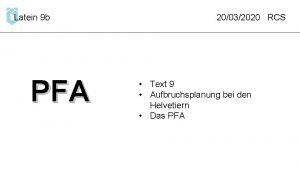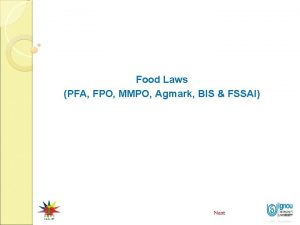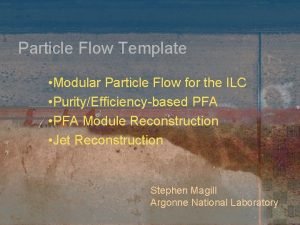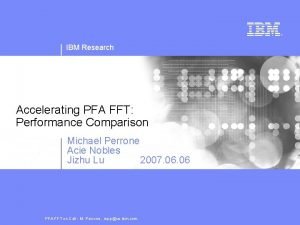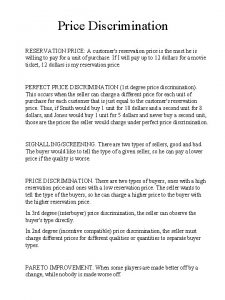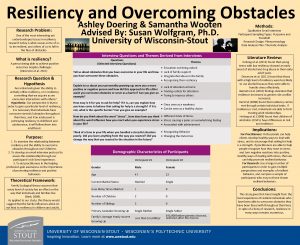PFA Ashley Ferrante Samantha Price Eric Stiner and



















- Slides: 19

PFA Ashley Ferrante, Samantha Price, Eric Stiner and Jed Vergara

What are PFAs? ● PFAs are per- and polyfluoroalkyl substances ○ Man-made ○ Persistent ■ Don’t break down ■ Accumulate over time

Where are PFAs found? ● Food ○ Packaging materials, processing equipment, soil or water ● Commercial household products ○ Paints, cleaning products, stain and waterrepellent fabrics ● Drinking water ● Living organisms ○ Fish, humans and animals ● Different workplace facilities and industries ○ Electronics manufacturing or oil recovery Figure 1: Sources of PFAs

Contaminant Properties ● ● ● ● Water soluble Bioaccumulative Fluoropolymer Perfluorooctanoic Acid (PFOA) Perfluorooctane Sulfonate (PFOS) Fire resistant Repels grease, oil, and stains Figure 2: Chemical Composition of 2 Types of PFAs

Regulations ● No EPA Maximum Contaminant Level for PFAs ○ Not under Safe Drinking Water Act ● Health Advisory Level of 0. 07 ppb in water ○ Nonregulatory, unenforced ○ Level where negative effects occur ● EPA determining if MCL is required ● State guidelines have been set

Human Health Effects ● Adverse health impact ● Different types of PFAs ○ PFOAs and PFOs ● Reproductive effects ○ Pregnancy, horomones ● Developmental progress in children ● Immune system ● Cancerous Figure 3: Types of PFAs

Environmental Impacts ● Found in water sources affecting fish, bird, seals, and dolphins ● Not only affects the quality of life of the animals but for certain species of anchovies and perch, the PFAs are then consumed by humans. ● As they are bioaccumulative they remain in the water and soil indefinitely ● Presenting issues in water sources near industrial cities

3 M versus the State of Minnesota ● 3 M is sued by the State of Minnesota for dumping toxic chemicals for 40 years ○ Production of Scotchgard fabric protector ○ The states says 3 M hid evidence from regulators ● Prior to the lawsuit ○ The company stopped making PFAs in 2002 ○ In 2004, trace amounts of the chemicals were found in groundwater near one of 3 M’s dumping sites ○ 3 M spent millions to clean up landfills and provide clean drinking ● 3 M considers the regulations set by the EPA 2016 “cautionary”

Results of a PFA testing in 2006 in public wells surrounding 3 M disposal site in Oakdale and Woodbury, Minnesota.

The Verdict ● 3 M owes the State of Minnesota $850 million after an 8 year trial ● No adverse human health correlations were ever proven ○ Minnesota 2006 results correlate to: ■ Cancers, leukemia, premature births, and lower fertility in the suburbs of St. Paul ● “We have our own problems in Minnesota with regulatory agencies captive to the industries they are supposed to regulate” - Lori Swanson MN Attorney General

Additional Contamination ● Contamination is an issue across the country: ○ Colorado & Pennsylvania - firefighter foam ○ Michigan - State of Emergency in Kalamazoo for PFA levels 20 times higher than regulation ○ North Carolina an investigation for high levels of PFA from airport and industrial complex ● No one wants to pay for the remediation of the “Forever Chemicals”

PFOA Stewardship Program ● 2006: EPA invited 8 major companies to join this program ○ 2 major goals ■ ■ 95% reduction in emissions and product levels by 2010 Elimination of chemicals by 2015 ● Companies included ○ ○ ○ ○ Arkema Asahi BASF Corporation Clariant Daikin 3 M/Dyneon Du. Pont Solvay Solexis ● All have met the goals

Water Remediation Methods ● Activated Carbon Adsorption ● Ion Exchange Resins ● High Pressure Membranes ● Plumestop ● pfas. CARE

Ex Situ Remediation Methods ● Activated Carbon Treatment ○ Highly porous filter ● Ion Exchange Treatment ○ Use ion exchange resins ○ Attract PFAS particles ● High Pressure Membranes ○ Nanofiltration ○ Reverse osmosis ○ Ultrafiltration

Plumestop Liquid Activated Carbon ● New In Situ method ○ No pumping required ○ Injected into the ground ● Sorbs PFAs and other contaminants ● Bacteria grow on the particles ○ Biodegrade the contaminants

pfas. CARE ● From a Australian Tech Company CRCCare ● Use electricity to produce extremely strong oxidising agents ● Strip PFAs of electrons ○ Breaks down contaminants ● Now Cheaper ○ Previously required diamonds

Soil/Solid Remediation ● Capping ○ Isolate PFAS contaminated material ● Excavation and Disposal ○ Removing contaminated soil ● Sorption and Stabilization ○ Additives in soil to reduce PFAS mobility ● Thermal ○ Heat to destroy the chemicals ○ Still developing

References “Basic Information on PFAS. ” (2018). EPA , Environmental Protection Agency, <https: //www. epa. gov/pfas/basic-information-pfas> (Dec. 8, 2018). Brueck, H. (2018). “Dangerous 'forever chemicals' have been found in US drinking water at alarmingly high rates - here's what to know about PFAS. ” Business Insider , Business Insider, <https: //www. businessinsider. com/what-are-pfas-chemicals-2018 -8>Benson, L. , and Bloomberg. com , Bloomberg, <https: //www. bloomberg. com/news/articles/2018 -02 -20/3 m-is-said-to-settle-minnesota-lawsuit-for-up-to-1 -billion> (Dec. 9, 2018). Finley, B. (2016). “Drinking water in three Colorado cities contaminated with toxic chemicals above EPA limits. ” The Denver Post , The Denver Post, <https: //www. denverpost. com/2016/06/15/colorado-widefield-fountain-security-water-chemicals-toxic-epa/> (Dec. 7, 2018). Hughes, A. (2007). “ 3 M chemicals found in drinking water of east metro cities. ” Minnesota Public Radio News , <https: //www. mprnews. org/story/2007/01/19/morepfc> (Dec. 9, 2018). Mc. Daniel, J. , and Mc. Crystal, L. (2016). “Tainted: How Navy bases contaminated Pa. drinking water. ” http: //www 2. philly. com , The Philadelphia Inquirer, Daily News and Philly. com, <http: //www 2. philly. com/philly/news/20160619_Tainted__How_Navy_bases_contaminated_Pa__drinking_water. html> (Dec. 9, 2018). Press, A. (2018). “Minnesota's $5 B case over 3 M chemicals heads to trial. ” The Washington Post , WP Company, <https: //www. washingtonpost. com/national/minnesotas-5 b-case-over-3 m-chemicals-heads-to-trial/2018/02/19/a 4 d 50 df 015 b 5 -11 e 8 -930 c-45838 ad 0 d 77 a_story. html? noredirect=on&utm_term=. 300031 d 5 ae 9 d> (Dec. 10, 2018). “Risk Management for Per- and Polyfluoroalkyl Substances (PFASs) under TSCA. ” (2018). EPA , Environmental Protection Agency, <https: //www. epa. gov/assessing-and-managing-chemicals-under-tsca/risk-management-and-polyfluoroalkyl-substances-pfass#tab-3 > (Dec. 8, 2018).

References Regenesis. (n. d. ). “Plume. Stop® Liquid Activated Carbon™. ” REGENESIS Remediation Solutions , <https: //regenesis. com/en/remediation-products/plumestop-liquid-activated-carbon/#1515095751951 -7880 b 2 b 5 -ffa 0> (Dec. 9, 2018). CRC CARE. (n. d. ). “World-first technique for eliminating toxic chemicals linked to firefighting foam contamination. ” CRC CARE , <https: //www. crccare. com/news/world-first-technique-for-eliminating-toxic-chemicals-linked-to-firefighting-foa m-contamination> (Dec. 9, 2018). Mueller, R. , and Yingling, V. (2018). “Remediation Technologies and Methods for Per- and Polyfluoroalkyl Substances (PFAS). ” Interstate Technology Regulatory Council , <https: //pfas-1. itrcweb. org/wp-content/uploads/2018/03/pfas_fact_sheet_remediation_3_15_18. pdf> US EPA. (2018). “Reducing PFAS in Drinking Water with Treatment Technologies. ” EPA , Environmental Protection Agency, <https: //www. epa. gov/sciencematters/reducing-pfas-drinking-water-treatment-technologies> (Dec. 9, 2018).
 Ashley ferrante
Ashley ferrante Ano ang ibig sabihin ng price floor
Ano ang ibig sabihin ng price floor Danny ferrante facebook
Danny ferrante facebook Paefs
Paefs Daniel ferrante md
Daniel ferrante md Ferrante ferrero
Ferrante ferrero Pfa sau srl pentru medici
Pfa sau srl pentru medici Pfa latein
Pfa latein Inventurum esse
Inventurum esse Food adulteration act
Food adulteration act Pfa
Pfa Pfa
Pfa Gateways to opportunity
Gateways to opportunity Pfa action principles
Pfa action principles Pfa conference 2018
Pfa conference 2018 Ibm pfa
Ibm pfa Price discovery and price determination
Price discovery and price determination Marked price-selling price=
Marked price-selling price= Difference between hire purchase and installment system
Difference between hire purchase and installment system Difference between reactive sourcing and strategic sourcing
Difference between reactive sourcing and strategic sourcing





